In five-and-a-half years of Buffer (wow!), we’ve been fortunate to cross many milestones — 3 million registered users, 90+ team members, and most recently, $10 million in annual recurring revenue (ARR).
Along this journey, we’ve been grateful for the support of the community and for the chance to gather new learnings along each step of the way.
Some of these lessons we gleaned easily — others we learned the hard way.
We’ve discovered the value of masterminds, data, and customer research. We embraced the idea of seeking conflicting advice. We grew from leaning on our strengths.
As I reflect back on the past five-and-a-half years at Buffer, I recognize there have been several key things we’ve learned that have helped us keep going. I’d love to share the list with you, to motivate and encourage you on your journey as well! Here are 10 of my biggest learnings in our Buffer journey on the road to $10 million ARR.
1. Experiment with a weekly mastermind with your co-founder
Investing in the relationship between my co-founder, Joel, and myself – on top of the work we are already doing on the startup – is extremely rewarding and useful.
When I talk to other founders about this, they sometimes tell me, “We’re already spending so much time together as co-founders, we know everything!”
I found this a quite easy trap to fall into, and I’ve thought this a time or two. However, I firmly believe our weekly masterminds have helped us solve so many more problems that we wouldn’t have otherwise.
Here’s a quick look at how we’ve set up our weekly masterminds:
- We take around 1-2 hours, preferably when it feels a bit less busy. Joel and I typically meet on a Friday.
- We talk for 10 minutes each about our achievements. These can be things like “I shipped this feature” or “I hit the gym 3 times this week.” As entrepreneurs, we often don’t celebrate our achievements enough and that can lead to burnout. Taking just a bit of time to think what is going great, even though there’s so much more to do, can be so valuable.
- We spend 40 minutes each on challenges. We try to really dive in and not stay on the surface. One consideration I’ve found helpful here is to avoid trying to solve each other’s problems, instead simply listening.
- At the end, we share feedback for each other. This helps ensure that things that might be bothering you don’t build up.
2. Avoid being distracted by data too early on
We live in a time where data is all around us, and there’s a lot of great advice to show us how to make better use of data. However, I’ve found that in some cases this can be a huge waste of time, especially early on with your startup.
I love this quote from one of our mentors Hiten Shah of KISSmetrics. He’s a guy that sells analytics and data software, so if he advocates that you don’t do that, I find that doubly encouraging.
“Most early stage startups won’t have enough customers to rely on quantitative data. You need to be acquiring hundreds of customers every month (preferably thousands) to have enough data to support A/B tests, etc.”
– Hiten Shah, Co-founder of CrazyEgg, KISSmetrics and QuickSprout
Replace some of your current focus on quantitative data to qualitative data (for example, a number of face-to-face discussions with your customers).
3. Ask these five questions to learn better from customers
“You need to learn how customers behave and what they need. In other words, focus on their problem, not their suggested solution.”
– Cindy Alvarez
Talking to customers and learning to do it well is something I’ve found to be extremely difficult in practice. It’s taken us a long time at Buffer to get a good process in place.
Here’s a simple way to immediately learn a lot from your customers with just five simple questions. These come from a book called Lean Customer Development by Cindy Alvarez, and I highly recommend it.
- Tell me about how you do _________ today….
- Do you use any [tools/products/apps/tricks] to help you get ________ done?
- If you could wave a magic wand and be able to do anything that you can’t do today, what would it be? Don’t worry about whether it’s possible, just anything.
- Last time you did ___________, what were you doing right before you got started? Once you finished, what did you do afterward?
- Is there anything else about _________ that I should have asked?
We use these 5 questions on a daily basis to make sure we’re learning valuable insights from customers.
The real key here is that you won’t see any leading questions. It’s important that there are no “Would you like it if…?” or “Would you use this…?” type of questions that could bias or influence a customer’s answer.
The magic wand question is one of my favorites. Everyone likes to be a magician. It can feel a bit out of place to ask that question sometimes, but I found it can jumpstart your customer’s creativity and perhaps even take the discussion into new directions.
4. Keep your data in house for more flexibility
At Buffer we’ve had a big rollercoaster ride when it comes to data.
We went from building in-house tools, to using an event tracking software, to building in-house tools, to using a third-party analytics tool again. And out of all that back and forth, the one thing we learned is to always at least store your data in house, even if you send it elsewhere. That can feel like a waste of effort, but it’s really not.
We found that too often when we use analytics software, and we give them our data, we don’t think we’ll need it ourselves. The truth is that no matter how good the software, it’ll never be a custom software that’s just for your product. There’ll still be ways that you’ll want to look at your data – ways that third-party software can’t give you. In our case, that can stop you from making some very important decisions.
Buffer’s journey with data
2010-11: In-house data-tools built by Joel
2012: Experimentation with various 3rd party event-tracking tools (KISSmetrics, Mixpanel)
2013-14: Moving back to build all data-tools in-house
2015-2016: Transitioning to using Looker
Making intelligent use of data has been one of the most difficult things for us at Buffer. We’ve switched tools often and our most recent transition to a tool called Looker currently feels like the most sustainable and long-term strategy we have for now.
5. The Bullseye Exercise: One channel to double down on
We sometimes feel that we want to use the “we’re just doing everything and we’ll see what sticks” strategy. As a small startup early in your growth, this can be a huge distraction.
At Buffer, we employed a single marketing strategy for the first year or so – which in our case was content marketing – and it’s been one of our best decisions in order not to spread ourselves too thin.
If you’re looking to figure out that one channel that works for you, I’d recommend the “bullseye exercise.”

Developed by Gabriel Weinberg, the founder of DuckDuckGo and author of Traction, there are three steps for you to go through to find the one marketing channel that works.
First, write down every marketing channel that’s possible. Then, narrow it down to three to four channels where you can run cheap and quick tests for no longer than a few weeks at a time. And then pick one single strategy that you double down on that you’ve found to be effective.
How to find your 1 channel that works:
- Outer ring: What’s possible – brainstorm all 19 traction channels there are
- Middle ring: What’s probable – Promote 3-4 most promising ideas and run tests
- Inner ring: What’s working – Focus solely on the 1 channel that’s working
What you’re really looking for is early repeatability; you want to be able to repeat a process as many times as possible and see a reward from it. That’s the best way to build momentum early and quickly.
This is really how you can lay sliver over sliver of small successes on top of each other, which will eventually create what we call the marketing flywheel. In the marketing flywheel, the sum of your individual efforts will be greater than each single one combined.
6. Seek conflicting advice from at least two mentors on your biggest decisions
This has been a particularly important lesson for myself, because the way I operate is quite opposite from this. I hear some advice from someone, and I’m hooked. I want to go ahead and do that thing immediately.
But this can be counter-productive to finding your own way and building an authentic business.
There are a lot of big decisions to make.
- Should you fundraise now and how much?
- Should you build that new product?
- Should you hire that person for that role?
For each decision, speak with someone that has one opinion and then immediately seek someone else’s opinion where you know he or she might think differently. You might be surprised by the varying perspectives and the ideas that might form.
7. Experiment with changing your prices often as you add value
We’re often so zoomed into our day-to-day work that we can easily forget how much value we’re adding to our products with the new features. Pricing changes often start with a huge barrier in our heads. We anticipate backlash, or that all of a sudden no one will pay us anymore.
Thus, there’s a mental barrier when it comes to pricing. Yet, in our experience, we haven’t quite found this to be the case.
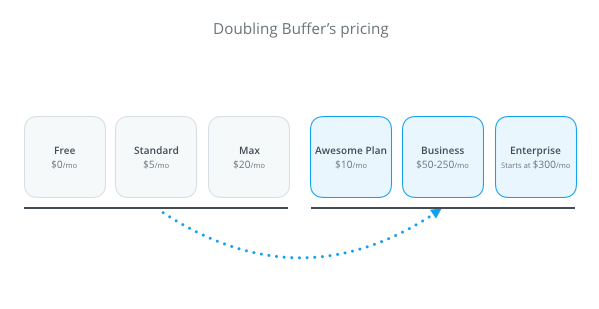
Here’s some real data on the pricing changes we’ve made at Buffer. One in particular was when we changed from $5 to $10 per month on our cheapest plan, we had a 0 change in conversion rate. We literally doubled our revenue from one day to the next.
As a note of caution, we usually like to grandfather all existing customers, so that’s important to keep in mind here.
8. Use the lean startup methodology for every feature you build, especially post-launch
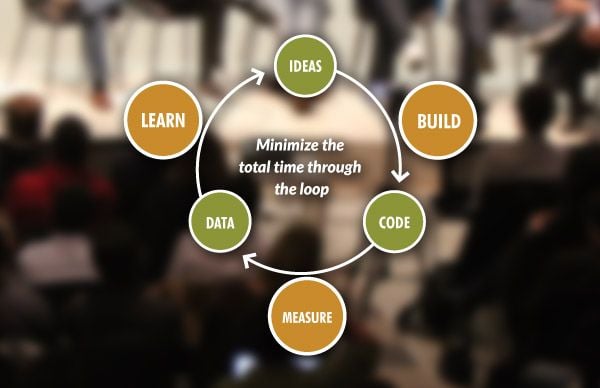
There’s a very strange phenomenon going on in the startup world. I discussed this with Hiten Shah once; I think he even had a special name for it.
It’s a law that goes: “Startups use the lean startup methodology once, then never again.”
I’m not quite sure why that is — maybe because we think once we follow it once, we then have all the knowledge about what to build in our heads.
At Buffer, we learned the hard way that we don’t know it. After Joel successfully used the lean startup methodology to launch Buffer, we then went on to build a number of features without talking with our customers about it or validating it in any meaningful way. That created a lot of waste.
And here’s how we got our lean startup mojo back. When we built a new product at Buffer, geared towards bigger businesses, which we called Buffer for Business, we were super disciplined about it again.
It’s still a bit embarrassing to think back to how we did it. This was our first pricing page of that product – it was literally a Wufoo page where people selected a plan, gave us their email and we would then by hand start a trial and get them setup.
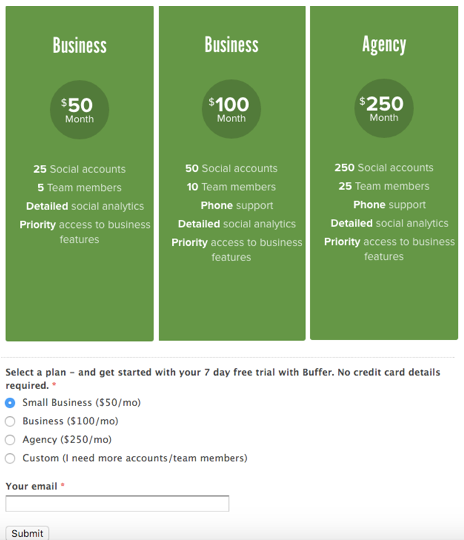
We went back to interviewing customers, building MVPs and so on. And Buffer for Business is now doing a little more than 45% of Buffer’s total revenue.
Since then, we institutionalized the lean startup methodology at Buffer, and we have four people full-time doing customer development with about 30 calls a week total.
We create a process for anything we’re building that would include the following.
- A hypothesis for the feature that could be invalidated.
- A customer development phase before building anything.
- A clickable prototype to get feedback even after we feel something is validated.
- And a roll-out of a working version that embarrasses us slightly.
9. When you get an offer to sell, list the experiences of personal growth you might miss
At Buffer we had four serious offers over the past five years. Not one of them was easy to work through.
When you consider an offer, make a list of the experiences you’re possibly leaving on the table if you sell.
We often think about how much money we could make now with selling, versus how much money we might make in the future. But sometimes, thinking about personal growth in both scenarios can be a more powerful indicator.
These are some of the things we would’ve missed out on learning if we sold:
- How to serve tens of thousands of customers
- How to let someone go
- How to hire key positions and train leaders
- How to acquire another company
- How to raise bigger funding rounds
- How to recover from a hack
At Buffer, we often talk about wanting to be a person of value, where we can offer advice to others and be useful. This is often only possible if you’ve had a lot of these experiences.
“Stop thinking about making a million dollars and start thinking about serving a million people.”
– Dharmesh Shah, Founder & CTO at HubSpot
10. Start getting better at your strengths and stop working on your weaknesses
At a recent in-person retreat for the Buffer Caretakers (we call our management team the “Caretakers”), we came to a conclusion that as a leadership team, we’d spent a lot of time working to bring up our weaknesses rather than fully lean into our strengths.
We reflected on the past year, and while we’d hit many incredible goals and achievements, there had been some bumps in the road and things weren’t exactly where we’d hoped they’d be. This led to some candid conversations and re-aligning of our goals and a focus on strengths that led to a restructuring for much of the team.
For example, I thrive on executing projects and getting results, while Joel’s strengths are in deep-thinking and problem solving. This led to our editor/operator model:
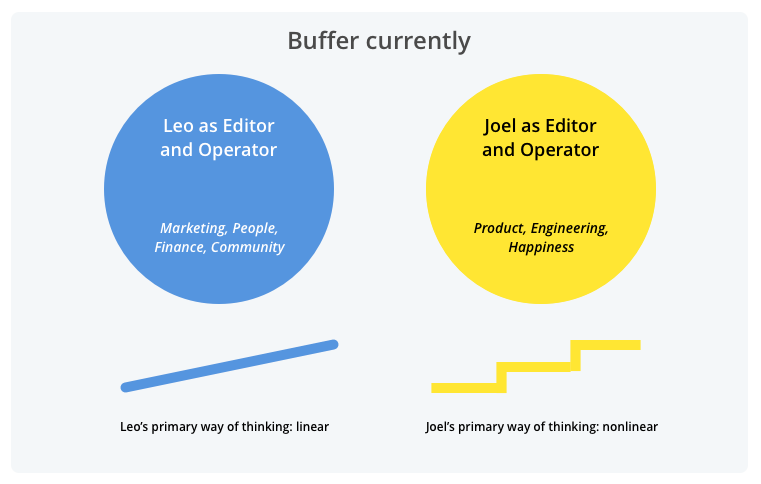
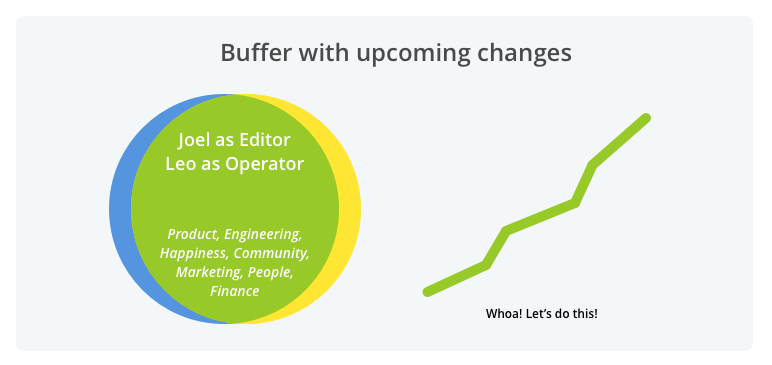
Embracing your strengths allows more forward momentum and can free you to move much more strongly as a team.
To illustrate further, my co-founder Joel also recently did a great Tweetstorm on this:
1/ In the last 2 months @leowid and I have fundamentally changed our roles as CEO and COO and the whole company structure. Some thoughts:
— Joel Gascoigne (@joelgascoigne) May 26, 2016
2/ For 2 years, our setup has been essentially ‘dividing the company’. It seemed logical, but we realized a number of challenges.
— Joel Gascoigne (@joelgascoigne) May 26, 2016
3/ Splitting the co seemed to play to our ‘functional’ strengths (e.g. product vs marketing), it actually didn’t play to true strengths.
— Joel Gascoigne (@joelgascoigne) May 26, 2016
4/ @leowid‘s strengths are operational, in making shit happen. Mine are more in editing, in rethinking things and getting details right.
— Joel Gascoigne (@joelgascoigne) May 26, 2016
5/ We both have thoughts on everything, operational thoughts vs editing thoughts. Functional separation always felt awkward.
— Joel Gascoigne (@joelgascoigne) May 26, 2016
6/ So 2 months ago we restructured ourselves to both work across the whole company, @leowid operationally, myself as company-wide editor.
— Joel Gascoigne (@joelgascoigne) May 26, 2016
7/ It’s still perhaps too soon to tell, but we have some early successes with this setup and overall we both feel much more pumped.
— Joel Gascoigne (@joelgascoigne) May 26, 2016
8/ I’ll keep you posted on how it feels as more time goes by and we have more learnings. Let me know if you have any questions! ?
— Joel Gascoigne (@joelgascoigne) May 26, 2016
Looking ahead to more growth and learnings
As I look back and ahead at all the lessons we have yet to stumble upon or sail through, I’m grateful for all of the ups and downs. The voyage to $10 million ARR has been truly unique, and I hope these learnings can help you as your company grows.
(Thanks to SaaStr for the video!)
I had the privilege of giving a talk on this topic at SaaStr Annual 2016. The full video of my talk is embedded at the bottom. You can continue reading for the full recap or jump to the video now.
Over to you
Do any of these surprise you or stand out? What are some of the biggest lessons you’ve learned in your job, career or company?
Photo Sources: Unsplash, Zapier, Lean Startup
Try Buffer for free
190,000+ creators, small businesses, and marketers use Buffer to grow their audiences every month.


